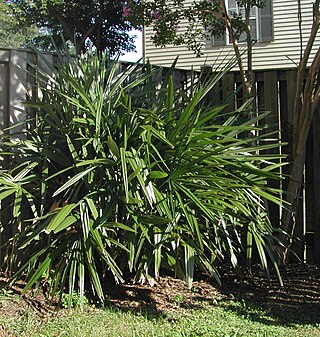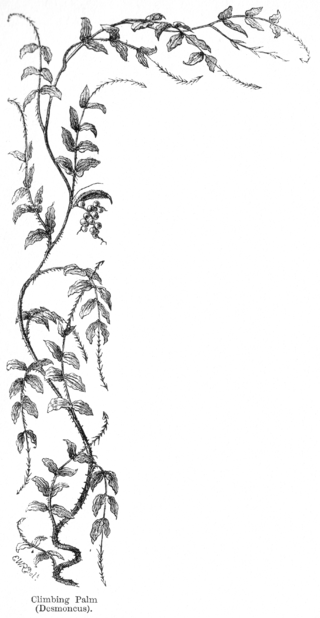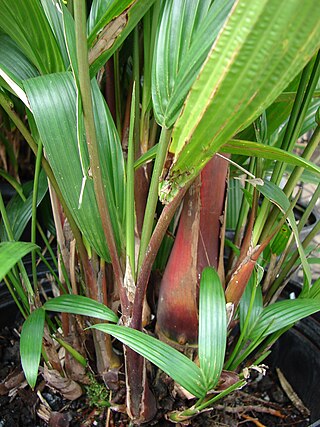
The Arecaceae is a family of perennial, flowering plants in the monocot order Arecales. Their growth form can be climbers, shrubs, tree-like and stemless plants, all commonly known as palms. Those having a tree-like form are called palm trees. Currently, 181 genera with around 2,600 species are known, most of which are restricted to tropical and subtropical climates. Most palms are distinguished by their large, compound, evergreen leaves, known as fronds, arranged at the top of an unbranched stem. However, palms exhibit an enormous diversity in physical characteristics and inhabit nearly every type of habitat within their range, from rainforests to deserts.

Rhapidophyllum hystrix, the needle palm, is a palm native to coastal margins of the subtropical eastern Gulf and south Atlantic states of the United States. Populations can be found from coastal southeast South Carolina, southward to Florida and west across the coastal plain of Mississippi and southern Alabama. It is one of the most cold-hardy palms in the world, and can be found growing in several areas with warm temperate climates.

Nannorrhops ritchiana, the Mazari palm, is the sole species in the genus Nannorrhops in the palm family Arecaceae.

Copernicia is a genus of palms native to South America and the Greater Antilles. Of the known species and nothospecies (hybrids), 22 of the 27 are endemic to Cuba. They are fan palms, with the leaves with a bare petiole terminating in a rounded fan of numerous leaflets. The species are small to medium-sized trees growing to 5–30 m tall, typically occurring close to streams and rivers in savanna habitats. The genus is named after the astronomer Nicolaus Copernicus. In some of the species, the leaves are coated with a thin layer of wax, known as carnauba wax.

Calyptrogyne is a genus in the palm family (Arecaceae). The distribution of this genus is Central America, Colombia, and southern Mexico, with 11 of the 17 known species endemic to Panama. Calyptrogyne ghiesbreghtiana is the most widespread and best studied species in this genus.

Butia is a genus of palms in the family Arecaceae, native to the South American countries of Brazil, Paraguay, Uruguay and Argentina. Many species produce edible fruits, which are sometimes used to make alcoholic beverages and other foods. The name is derived from a Brazilian vernacular word for members of the genus.

Iriartea is a genus in the palm family Arecaceae, native to Central and South America. The best-known species – and probably the only one – is Iriartea deltoidea, which is found from Nicaragua, south into Bolivia and a great portion of Western Amazonian basin. It is the most common tree in many forests in which it occurs.

Ceroxylon quindiuense, often called Quindío wax palm, is a palm native to the humid montane forests of the Andes in Colombia and Peru.

The Cocora valley is a valley in the Quindío Department of Colombia. It is located in the Central Cordillera of the Andean mountains. "Cocora" was the name of a Quimbayan princess, daughter of the local chief Acaime, and means "star of water".

Desmoncus is a genus of mostly climbing, spiny palms native to the Neotropics. The genus extends from Mexico in the north to Brazil and Bolivia in the south, with two species present in the southeastern Caribbean.

Rhapis is a genus of about 10 species of small palms native to southeastern Asia from southern Japan and southern China south to Sumatra. The species are commonly known as lady palms. They are fan palms, with the leaves with a bare petiole terminating in a rounded fan of numerous leaflets. The plants have thin stems growing to 3–4 m tall, branching at the base, forming clumps and are dioecious, with male and female flowers produced on separate plants.

Cyrtostachys is a genus of flowering plant in the family Arecaceae. Its species are found in southeast Asia, New Guinea, and in some of the South-Central and Southwest Pacific island habitats of the Oceanian realm.

Euterpe precatoria is a tall, slender-stemmed, pinnate-leaved palm native to Central and South America and Trinidad and Tobago. E. precatoria is used commercially to produce fruits, although Euterpe oleracea is more commonly cultivated due to its larger fruits.

Guihaia is a genus of three species of dioecious palms found in China and Vietnam. Perhaps its most distinctive characteristic is that it is the only palm with palmate leaves that has reduplicate (A-shaped) leaf folds. All other palmate leaves have induplicate (V-shaped) leaf folds. Guihaia lancifolia has undivided leaves.

Pholidostachys is a genus of palms found in Central America and northwestern South America.

Welfia is a genus of palms found in Central America and northwestern South America. Only two species are currently recognized: Welfia regia and Welfia alfredii.

Lepidocaryum is a monotypic genus of flowering plant in the palm family from South America where the lone species, Lepidocaryum tenue, is commonly called poktamui. Nine species names have been published, but palm taxonomists currently agree that just one variable species includes them all. The most reduced member of the Lepidocaryeae, it is similar in appearance to three closely related genera, Mauritia, Mauritiella, and Lytocaryum. The genus name combines the Greek words for "scale" and "nut" and the species epithet is Latin for "thin".

Roystonea oleracea, sometimes known as the Caribbean royal palm, palmiste, imperial palm or cabbage palm, is a species of palm which is native to the Lesser Antilles, Colombia, Venezuela, and Trinidad and Tobago. It is also reportedly naturalized in Guyana and on the islands of Mauritius and Réunion in the Indian Ocean.

Ceroxylon vogelianum, also known as the Vogels wax palm is a palm native to the Andes from Venezuela south to Peru in humid montane forest, at an elevation of 1900 – 2900 meters.
Ceroxylon peruvianum is a species of palm tree. It is endemic to Peru.




























